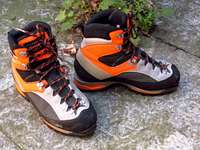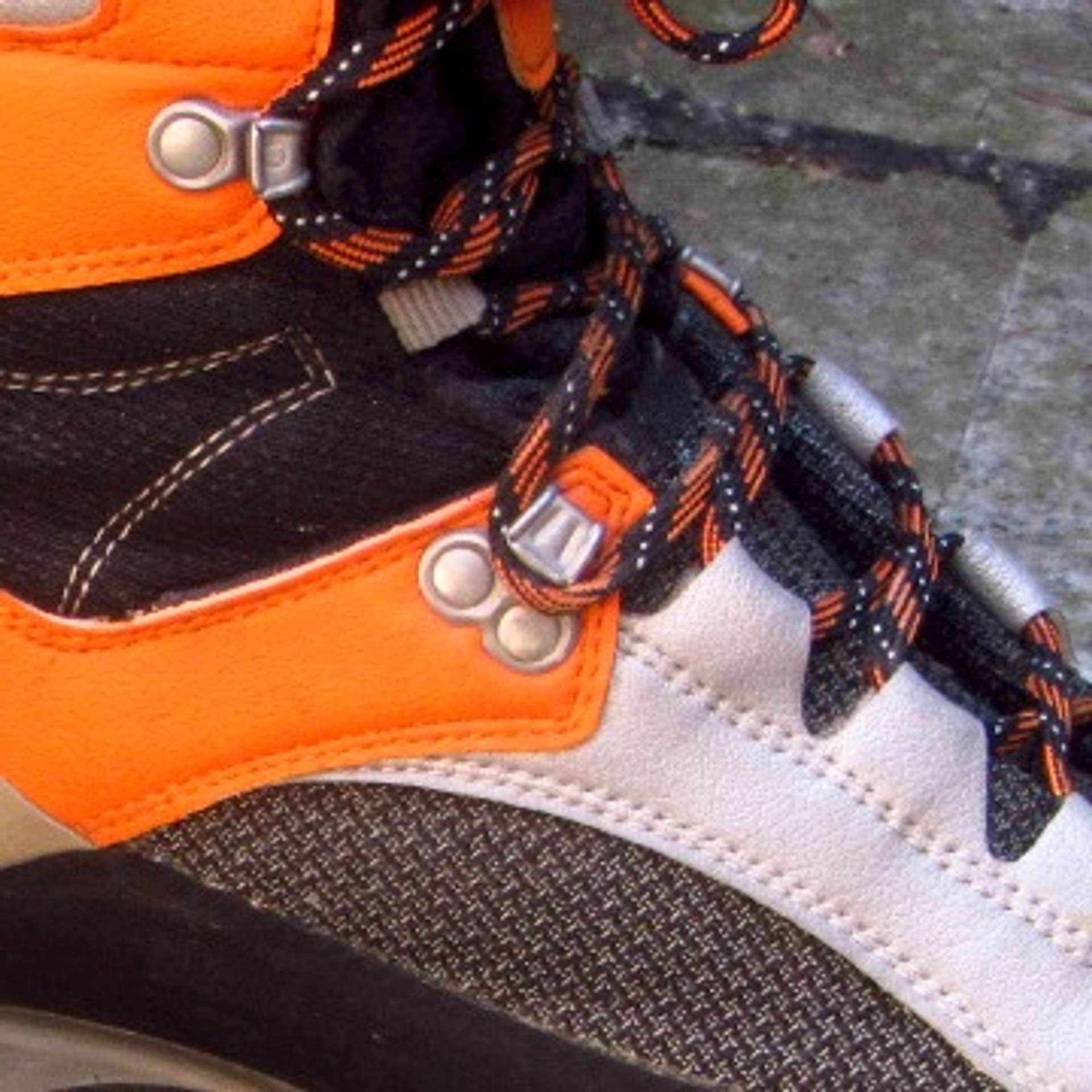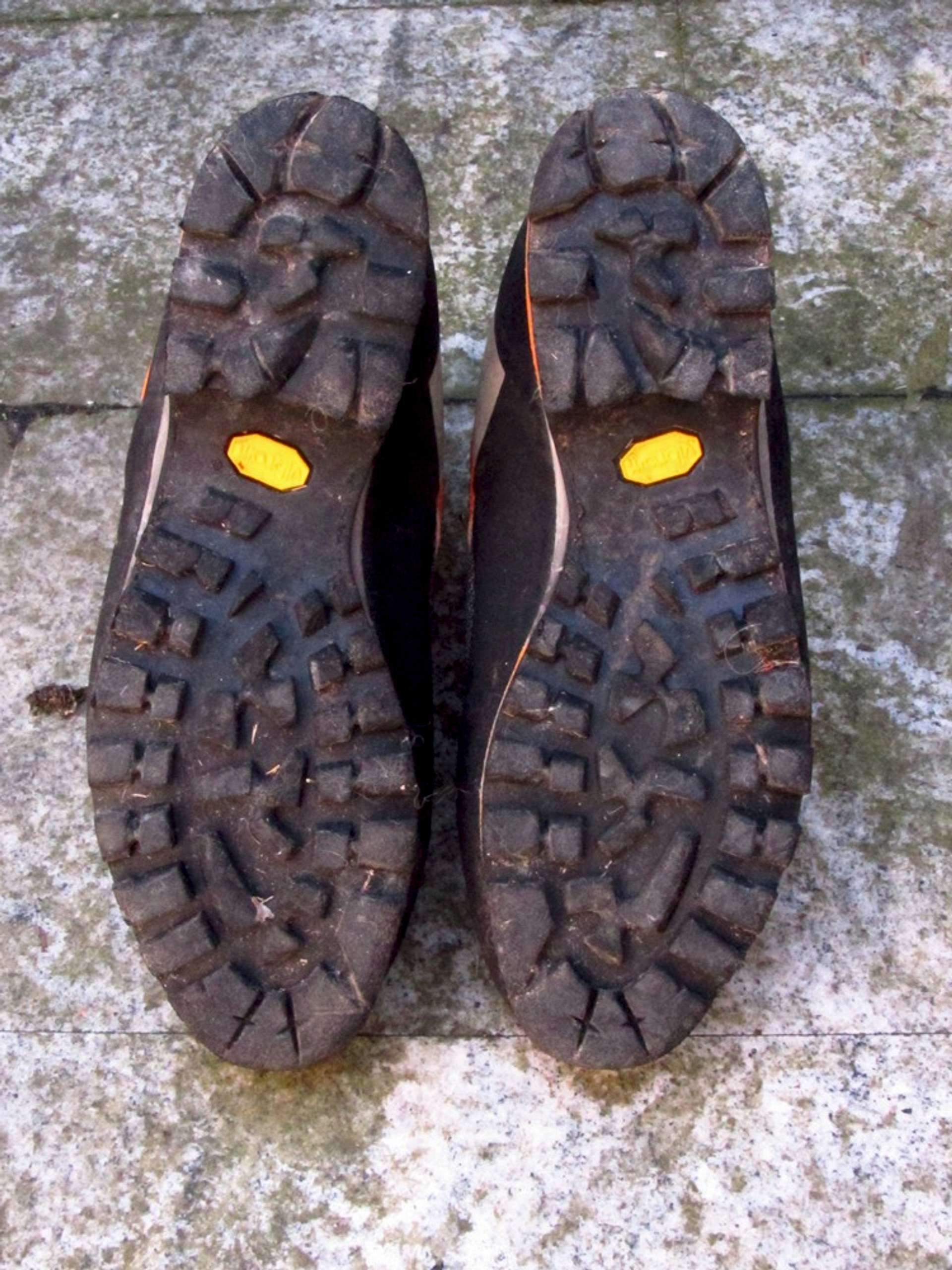Scarpa Jorasses Pro GTX
Product Description
The Scarpa Jorasses Pro GTX is a technical mountaineering boot, primarily intended for summer mountaineering on all types of routes.I've used them extensively during almost 6 weeks all over the Alps, and they didn't show much wear - the attached photos are from back home, after the trip. They performed splendidly on routes varying from easy walk ups up to the Dufourspitze route from Capanna Margherita over the Grenzsattel. Haven't tried anything harder with them (yet).
As to the color? Yes, they really are bright orange!
Features
It's a D-type boot, meaning that it has a very stiff sole which is ideal for crampons. It can handle step-in style crampons, such as my Black Diamond Sabretooth Pros, as well as any other style. However, while the sole is rigid, around the ankle the boot is quite flexible, which makes it relatively easy to walk in, especially if you don't lace it up too tight. Talking about lacing, two special eyelets make it very easy to lace the bottom real tight and yet leave the upper shaft pretty loose. On ascending, I prefer to lace my boots a bit tight only on technical terrain, and pretty loose otherwise, but when I descend, I like to lace up the bottom part real tight so my toes don't touch the front (but sometimes I forget, and then my toes will remind me for a year).Being new, it's no surprise the boots were waterproof - I hiked in heavy rain, waded through mountain streams and walked on some pretty wet glaciers, but apart from dampness caused by a bit of sweat, my feet stayed dry. And almost always the dampness had all but evaporated by the next morning. However, this is to be expected from a new technical boot, and only time can tell how long they will stay this water resistant. The lining is Gore-Tex®, the outer layer a mixture of materials, including rubber and some synthetic materials. The sole is by Vibram®.
Strangely enough, although the front part of the boot is relatively small, I had plenty of room for my toes to wiggle in any direction. Mind you. I bought a size 43, where my regular shoe size is 42. I would have liked to try a 42.5, but this boot doesn't come in half sizes.
The weight is 1.7 kg per pair (size 42 EU / 8½ US), but once I put them on they didn't feel heavy at all. Part of the weight is explained by the fact that there is lots of cushioning everywhere, which I appreciate very much. This padding also helps to insulate, and I had cold feet only twice: once in the morning when it was well below freezing, the other time when my feet got sweaty from the approach hike and I then had to stand around, waiting for my climbing partners to move on the rocks.
Right out of the box, I wore them without putting any tape on my feet, and didn't get any blisters. For ascending, they felt fine immediately, but for descending it took a couple of weeks for my feet and these boots to get properly acquainted: because they were a lot stiffer than my old boots, it took a bit of time.
After a month or so, at the end of a warm day, I unexpectedly felt some irritation on the inside of one of my feet, directly below my ankle. Never had any problems at that spot before, but when I checked, it was red, so I put a Compeed® on it to prevent further trouble and that helped. The other foot was alright. A week later I started feeling something similar developing early in the day, so I put some tape on my feet, both of them this time, which worked fine. I suppose it's a matter of friction, because there is perhaps a little bit too much room around that spot, and the irritation is exacerbated by warm temperatures.
Images
Reviews
Viewing: 1-2 of 2 |
JLuthanen - Oct 3, 2015 10:30 am - Hasn't voted
Get these sized correctly, and you won't be disappointed
Owned these for about 3 years until selling them this summer - had to have been one half size too small. Blisters nearly every trip, definite pain with at least a small side of neuropathy after every climb. They are bombproof though - 2x up Rainier, 1x Baker, multiple other 2 day climbs and held up under adverse conditions - still had plenty of life left.
Attempted originally to 'rush' fit these boots by hiking with water in them on roads at the recommendation of a previous guide - worked a little, but not well enough. Definitely waterproof and my best fit was eventually achieved via SuperFeet green insoles, coupled with CEP compression socks and some generic hiker outer socks (and duct tape over my heel under all).
Attempted originally to 'rush' fit these boots by hiking with water in them on roads at the recommendation of a previous guide - worked a little, but not well enough. Definitely waterproof and my best fit was eventually achieved via SuperFeet green insoles, coupled with CEP compression socks and some generic hiker outer socks (and duct tape over my heel under all).
Viewing: 1-2 of 2 |









rgg - Aug 1, 2013 11:58 am - Voted 5/5
Great boots!In the shop, these felt good - if they hadn't, I wouldn't have bought them. They had lots of padding, yet left enough wiggling room for my toes (I bought them size 43, where my regular shoe size is 42). Once I got to the mountains, I found that they did great on ascending, but their stiffness made descending a bit harder than my old boots. It took a couple of weeks to get used to that, and since then I love them!